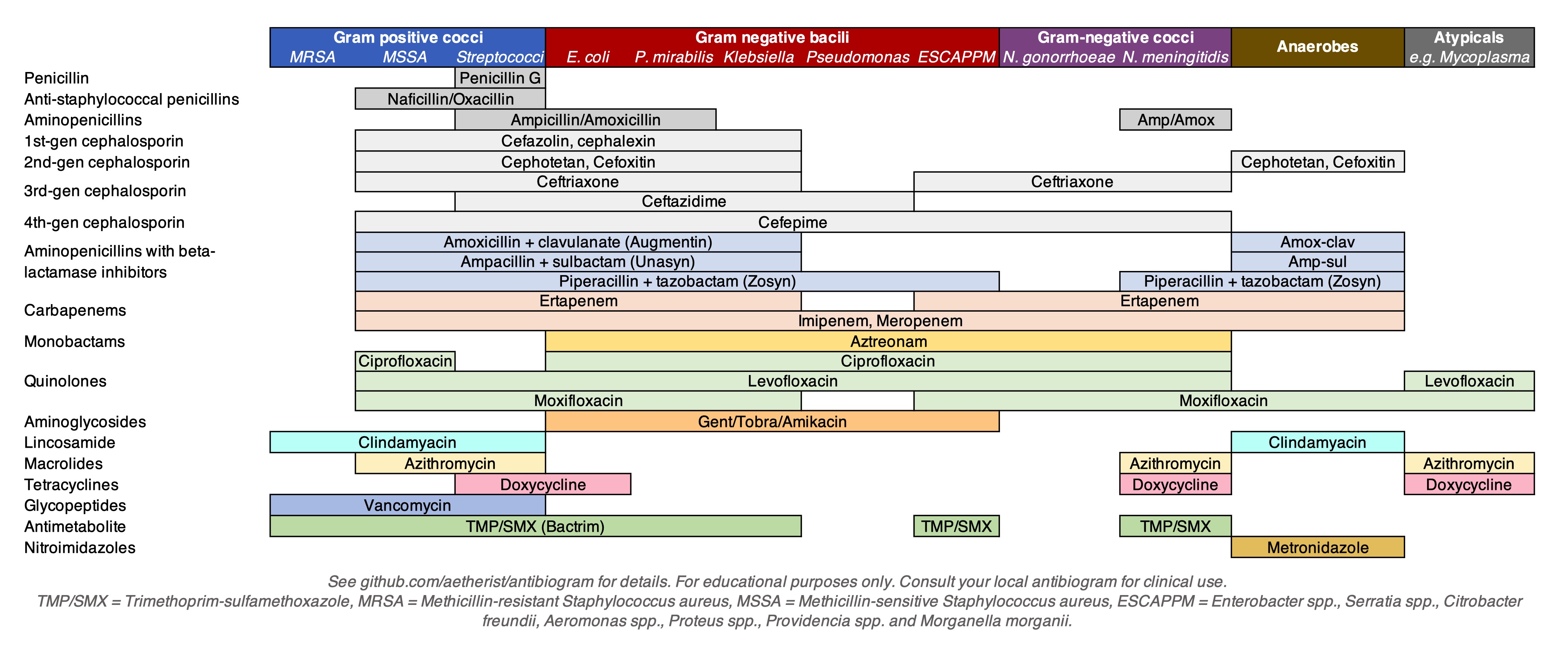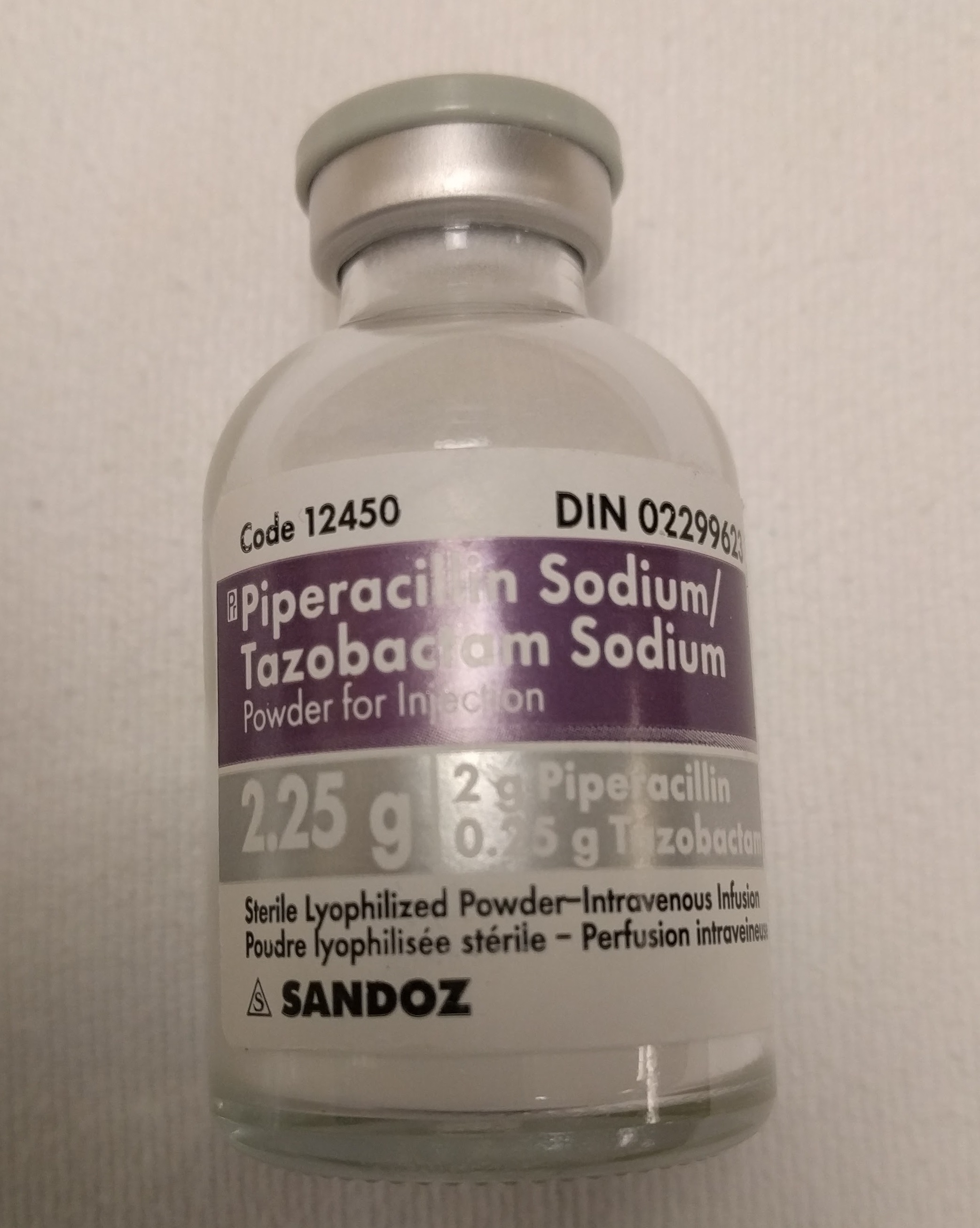|
Antibiotic Classes
The following is a list of antibiotics. The highest division between antibiotics is bactericidal and bacteriostatic. Bactericidals kill bacteria directly, whereas bacteriostatics prevent them from dividing. However, these classifications are based on laboratory behavior. The development of antibiotics has had a profound effect on the health of people for many years. Also, both people and animals have used antibiotics to treat infections and diseases. In practice, both treat bacterial infections. By coverage The following are lists of antibiotics for specific microbial coverage (not an exhaustive list): MRSA Antibiotics that cover Methicillin-resistant Staphylococcus aureus, methicillin-resistant ''Staphylococcus aureus'' (MRSA): * Vancomycin * Teicoplanin * Linezolid * Daptomycin * Trimethoprim/sulfamethoxazole * Doxycycline * Ceftobiprole (5th generation) * Ceftaroline (5th generation) * Clindamycin * Dalbavancin * Delafloxacin * Fusidic acid * Mupirocin (topical) * Omadacycline ... [...More Info...] [...Related Items...] OR: [Wikipedia] [Google] [Baidu] |
Antibiotic
An antibiotic is a type of antimicrobial substance active against bacteria. It is the most important type of antibacterial agent for fighting pathogenic bacteria, bacterial infections, and antibiotic medications are widely used in the therapy, treatment and antibiotic prophylaxis, prevention of such infections. They may either bactericide, kill or bacteriostatic agent, inhibit the growth of bacteria. A limited number of antibiotics also possess antiprotozoal activity. Antibiotics are not effective against viruses such as the ones which cause the common cold or influenza. Drugs which inhibit growth of viruses are termed antiviral drugs or antivirals. Antibiotics are also not effective against fungi. Drugs which inhibit growth of fungi are called antifungal drugs. Sometimes, the term ''antibiotic''—literally "opposing life", from the Greek language, Greek roots ἀντι ''anti'', "against" and βίος ''bios'', "life"—is broadly used to refer to any substance used against ... [...More Info...] [...Related Items...] OR: [Wikipedia] [Google] [Baidu] |
Mupirocin
Mupirocin, sold under the brand name Bactroban among others, is a topical antibiotic useful against superficial skin infections such as impetigo or folliculitis. It may also be used to get rid of methicillin-resistant ''S. aureus'' (MRSA) when present in the nose without symptoms. Due to concerns of developing resistance, use for greater than ten days is not recommended. It is used as a cream or ointment applied to the skin. Common side effects include itchiness and rash at the site of application, headache, and nausea. Long-term use may result in increased growth of fungi. Use during pregnancy and breastfeeding appears to be safe. Mupirocin is chemically a carboxylic acid. It works by blocking a bacteria's ability to make protein, which usually results in bacterial death. Mupirocin was initially isolated in 1971 from ''Pseudomonas fluorescens''. It is on the World Health Organization's List of Essential Medicines. In 2022, it was the 162nd most commonly prescribed medic ... [...More Info...] [...Related Items...] OR: [Wikipedia] [Google] [Baidu] |
Piperacillin/tazobactam
Piperacillin/tazobactam, sold under the brand name Tazocin among others, is a combination medication containing the antibiotic piperacillin and the β-lactamase inhibitor tazobactam. The combination has activity against many Gram-positive and Gram-negative bacteria including ''Pseudomonas aeruginosa''. It is used to treat pelvic inflammatory disease, intra-abdominal infection, pneumonia, cellulitis, and sepsis. It is given by injection into a vein. Common adverse effects include headache, trouble sleeping, rash, nausea, constipation, and diarrhea. Serious adverse effects include ''Clostridioides difficile'' infection and allergic reactions including anaphylaxis. Those who are allergic to other β-lactam are more likely to be allergic to piperacillin/tazobactam. Use in pregnancy or breastfeeding appears to generally be safe. It usually results in bacterial death through blocking their ability to make a cell wall. Piperacillin/tazobactam was approved for medical use in the ... [...More Info...] [...Related Items...] OR: [Wikipedia] [Google] [Baidu] |
Piperacillin
Piperacillin is a broad-spectrum β-lactam antibiotic of the ureidopenicillin class. The chemical structure of piperacillin and other ureidopenicillins incorporates a polar side chain that enhances penetration into Gram-negative bacteria and reduces susceptibility to cleavage by Gram-negative beta lactamase enzymes. These properties confer activity against the important hospital pathogen ''Pseudomonas aeruginosa''. Thus piperacillin is sometimes referred to as an "anti-pseudomonal penicillin". When used alone, piperacillin lacks strong activity against the Gram-positive bacteria, Gram-positive pathogens such as ''Staphylococcus aureus'', as the beta-lactam ring is hydrolyzed by the bacteria's beta-lactamase. It was patented in 1974 and approved for medical use in 1981. Piperacillin is most commonly used in combination with the β-Lactamase inhibitor, beta-lactamase inhibitor tazobactam (piperacillin/tazobactam), which enhances piperacillin's effectiveness by inhibiting many bet ... [...More Info...] [...Related Items...] OR: [Wikipedia] [Google] [Baidu] |
Cefiderocol
Cefiderocol, sold under the brand name Fetroja (by Shionogi) among others, is an antibiotic used to treat complicated urinary tract infections when no other options are available. It is indicated for the treatment of multi-drug-resistant Gram-negative bacteria including ''Pseudomonas aeruginosa''. It is given by injection into a vein. Common side effects include diarrhea, infusion site reactions, constipation and rash. Cefiderocol is in the cephalosporin family of medications. It was approved for medical use in the United States in November 2019, and in the European Union in April 2020. In September 2020, cefiderocol (Fetroja) received FDA approval as supplemental New Drug Application (sNDA) for treatment of hospital-acquired bacterial pneumonia (HABP) and ventilator-associated bacterial pneumonia (VABP) when caused by Gram-negative bacteria resistant to other antibiotics. It is on the World Health Organization's List of Essential Medicines. Medical uses Cefiderocol is us ... [...More Info...] [...Related Items...] OR: [Wikipedia] [Google] [Baidu] |
Ceftazidime/avibactam
Ceftazidime/avibactam, sold under the brand name Avycaz (by AbbVie) among others, is a fixed-dose combination medication composed of ceftazidime, a cephalosporin antibiotic, and avibactam, a Beta-lactamase inhibitor, β-lactamase inhibitor. It is used to treat complicated intra-abdominal infections, urinary tract infections, and pneumonia. It is only recommended when other options are not appropriate. It is given by infusion into a vein. Common side effect include nausea, fever, liver problems, headache, trouble sleeping, and pain at the site of infusion. Severe side effects may include anaphylaxis, seizures, and Clostridioides difficile infection, ''Clostridioides difficile''-associated diarrhea. While use appears to be safe in pregnancy the medication has not been well studied in this group. Doses should be adjusted in those with kidney problems. Ceftazidime works by interfering with the building of the bacterial cell wall while avibactam works by preventing ceftazidime's brea ... [...More Info...] [...Related Items...] OR: [Wikipedia] [Google] [Baidu] |
Ceftolozane
Ceftolozane/tazobactam, sold under the brand name Zerbaxa, (Merck) is a combination antibiotic, fixed-dose combination antibiotic medication used for the treatment of complicated urinary tract infections and complicated intra-abdominal infections in adults. Ceftolozane is a cephalosporin antibiotic, developed for the treatment of infections with gram-negative bacteria that are Antibiotic resistance, resistant to conventional antibiotics. It was studied for urinary tract infections, intra-abdominal infections and ventilator-associated bacterial pneumonia. The most common side effects include nausea (feeling sick), headache, constipation, diarrhea and fever. Text was copied from this source which is copyright European Medicines Agency. Reproduction is authorized provided the source is acknowledged. Ceftolozane is a type of antibiotic called a cephalosporin, which belongs to the wider group of antibiotics called beta-lactams. It works by interfering with the production of molecules ... [...More Info...] [...Related Items...] OR: [Wikipedia] [Google] [Baidu] |
Cefepime
Cefepime is a fourth-generation cephalosporin antibiotic. Cefepime has an extended spectrum of activity against Gram-positive and Gram-negative bacteria, with greater activity against both types of organism than third-generation agents. A 2007 meta-analysis suggested when data of trials were combined, mortality was increased in people treated with cefepime compared with other β-lactam antibiotics. In response, the U.S. Food and Drug Administration (FDA) performed their own meta-analysis which found no mortality difference. Cefepime was patented in 1982 by Bristol-Myers Squibb and approved for medical use in 1994. It is available as a generic drug and sold under a variety of trade names worldwide. It was removed from the World Health Organization's List of Essential Medicines in 2019. Medical use Cefepime is usually reserved to treat moderate to severe nosocomial pneumonia, infections caused by multiple drug-resistant microorganisms (e.g. ''Pseudomonas aeruginosa'') and ... [...More Info...] [...Related Items...] OR: [Wikipedia] [Google] [Baidu] |
Ceftazidime
Ceftazidime, sold under the brand name Fortaz among others, is a third-generation cephalosporin antibiotic useful for the treatment of a number of bacterial infections. Specifically it is used for joint infections, meningitis, pneumonia, sepsis, urinary tract infections, malignant otitis externa, ''Pseudomonas aeruginosa'' infection, and vibrio infection. It is given by injection into a vein, muscle, or eye. Common side effects include nausea, allergic reactions, and pain at the site of injection. Other side effects may include ''Clostridioides difficile'' diarrhea. It is not recommended in people who have had previous anaphylaxis to a penicillin. Its use is relatively safe during pregnancy and breastfeeding. It is in the third-generation cephalosporin family of medications and works by interfering with the bacteria's cell wall. Ceftazidime was patented in 1978 and came into commercial use in 1984. It is on the World Health Organization's List of Essential Medicines. Ce ... [...More Info...] [...Related Items...] OR: [Wikipedia] [Google] [Baidu] |
Pseudomonas Aeruginosa
''Pseudomonas aeruginosa'' is a common Bacterial capsule, encapsulated, Gram-negative bacteria, Gram-negative, Aerobic organism, aerobic–facultative anaerobe, facultatively anaerobic, Bacillus (shape), rod-shaped bacteria, bacterium that can cause disease in plants and animals, including humans. A species of considerable medical importance, ''P. aeruginosa'' is a multiple drug resistance, multidrug resistant pathogen recognized for its ubiquity, its Intrinsic and extrinsic properties, intrinsically advanced antibiotic resistance mechanisms, and its association with serious illnesses – hospital-acquired infections such as ventilator-associated pneumonia and various sepsis syndromes. ''P. aeruginosa'' is able to selectively inhibit various antibiotics from penetrating its outer membrane'' ''– and has high resistance to several antibiotics. According to the World Health Organization ''P. aeruginosa'' poses one of the greatest threats to humans in terms of an ... [...More Info...] [...Related Items...] OR: [Wikipedia] [Google] [Baidu] |
Tigecycline
Tigecycline, sold under the brand name Tygacil, is a tetracycline antibiotic medication for a number of bacterial infections. It is a glycylcycline class drug that is administered intravenously. It was developed in response to the growing rate of antibiotic resistant bacteria such as ''Staphylococcus aureus'', ''Acinetobacter baumannii'', and '' E. coli''. As a tetracycline derivative antibiotic, its structural modifications has expanded its therapeutic activity to include Gram-positive and Gram-negative organisms, including those of multi-drug resistance. It was given a U.S. Food and Drug Administration (FDA) fast-track approval and was approved on 17 June 2005. It was approved for medical use in the European Union in April 2006. It was removed from the World Health Organization's List of Essential Medicines in 2019. The World Health Organization classifies tigecycline as critically important for human medicine. Medical uses Antibacterial use Tigecycline is used to ... [...More Info...] [...Related Items...] OR: [Wikipedia] [Google] [Baidu] |
Telavancin
Telavancin (trade name Vibativ by Cumberland Pharmaceuticals) is a bactericidal lipoglycopeptide for use in MRSA or other Gram-positive infections. Telavancin is a semi-synthetic derivative of vancomycin. The FDA approved the drug in September 2009 for complicated skin and skin structure infections (cSSSI), and in June 2013 for hospital-acquired and ventilator-associated bacterial pneumonia caused by Staphylococcus aureus. History On 19 October 2007, the US Food and Drug Administration (FDA) issued an approvable letter for telavancin. Its developer, Theravance, submitted a complete response to the letter, and the FDA has assigned a Prescription Drug User Fee Act (PDUFA) target date of 21 July 2008. On 19 November 2008, an FDA antiinfective drug advisory committee concluded that they would recommend telavancin be approved by the FDA. The FDA approved the drug on 11 September 2009 for complicated skin and skin structure infections ( cSSSI). Theravance has also submitted t ... [...More Info...] [...Related Items...] OR: [Wikipedia] [Google] [Baidu] |




